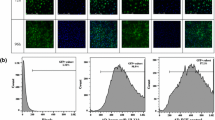Summary
To construct the recombinant adenovirus vector containing the cDNA for human vascular endothelial growth factor (hVEGF165), the cDNA for hVEGF165 was subcloned into pACCMV · pLpA. Subsequently, this recombinant pACCMV · hVEGF was co-transfected into 293 cells together with pJM17 to obtain the replication-deficient recombinant adenovirus containing hVEGF gene — Ad-CMV · hVEGF. The VEGF gene expression was detected by using RT-PCR and Western blot in rabbit aorta vascular smooth muscle cells (VSMC) infected with AdCMV · hVEGF. Cultured human umbilical vein endothelial cells (HUVEC) were incubated with the conditioned medium (CM) from above mentioned VSMC infected with AdCMV · hVEGF to observe the effect of VEGF on proliferation of HUVEC. 48 h after the infection with AdCMV · hVEGF, VSMC demonstrated VEGF expression, and the expressed VEGF could stimulate the proliferation of HUVECin vitro. Successfully prepared AdCMV · hVEGF165 could express biologically active VEGF in infected VSMC, and stimulate proliferation of HUVEC.
Similar content being viewed by others
References
Hariawala M, Horowitz J R, Esakof Det al. VEGF accelerates collateral development in porcine hearts. J Surg Res, 1996, 63:77
Takeshita S, Weir L, Chen D Fet al. Therapeutic angiogenesis following arterial gene transfer of VEGF in a rabbit model of hindlimb ischemia. Biochem Biophys Res Commun, 1996, 227(2):628
Isner J M, Pieczek A, Schainfeld Ret al. Early report: clinical evidence of angiogenesis after arterial gene transfer of phVEGF165 in patient with ischemic limb. Lancet, 1996, 348:370
Isner J M, Pieczek A, Schainfeld Ret al. Arterial gene transfer of naked DNA in patients with critical limb ischemia. Circulation, 1996, 94(8): supplI-591
Vale P R, Losordo D W, Symes J Fet al. Gehe therapy for myocardial angiogenesis. Circulation, 1998, 98 (suppl-1): I -322
Asahara T, Chen D H, Tsurumi Yet al. Accelerated restitution of endothelial integrity and endothelium-dependent function after phVEGF165 gene transfer. Circulation, 1996, 94:3291
Belle E V, Tio F O, Chen D Het al. Passivation of metallic stents after arterial gene transfer of phVEGF165 inhibits thrombus formation and intimal thickening. J Am Coll Cardiol, 1997, 29:1371
Laitinen M, Hartikainen J, Eranen Jet al. Catheter-mediated VEGF gene transfer to human coronary arteries after angioplasty. Safety results from phase I Kuopio Angioplasty Gene Transfer Trial (KAT Trial). Circulation, 1998, 98(suppl-1): 1–322
1987, 16(4):260
Sambrook J, Fritsch E F, Maniatis Tet al. Molecular Cloning. 2nd ed. New York:Cold Spring Harbor Laboratory Press, 1989.
Wilson L, Becker TC. Methods in Cell Biology. Vol 43. New York:Academic Press, 1994, 174
DNA 1990, 13(2):91
Author information
Authors and Affiliations
Rights and permissions
About this article
Cite this article
Qigong, L., Zaiying, L., Weidong, Z. et al. Construction and identification of recombinant adenovirus vector containing the hVEGF165 gene. Current Medical Science 20, 186–189 (2000). https://doi.org/10.1007/BF02886984
Received:
Published:
Issue Date:
DOI: https://doi.org/10.1007/BF02886984




